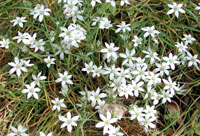Resource Library
Plant of the Week: Star of Bethlehem
The University of Arkansas System Division of Agriculture does not promote, support or recommend plants featured in "Plant of the Week." Please consult your local Extension office for plants suitable for your region.
Plant of the Week
Star of Bethlehem
Latin: Ornithogalum umbellatum

Mention "the one that got away," and you automatically think of fish, not flowers. One of these floral escapees, the Star of Bethlehem (Ornithogalum umbellatum), has become a nuisance in gardens and lawns when allowed to run wild.
What are the characteristics of Star of Bethlehem?
Star of Bethlehem is a winter bulb of the lily family native to the Mediterranean region. From thumb-sized white, naked bulbs, it begins sending up tufts of bright green leaves in late winter. Each grass-like leaf is marked with a white line down the midrib. Large bulbs produce many offsets so the clumps of foliage may be 6 inches across.
The clumps of foliage somewhat resemble wild garlic except star of Bethlehem has no odor when the foliage is crushed. Also, garlic foliage tends to grow straight up while this species has arching leaves. Both stand out vividly in late winter against the beige backdrop of zoysiagrass or bermudagrass lawns. The leaves die as summer arrives and the bulbs go dormant.
Flowering
In late April or early May, it sends up a 10-inch tall multi-flowered spike bearing from 12 to 30 white, six-petaled star-like blooms. The backsides of the petals are marked with a broad band of green. The flowers open in the morning and close each evening.
Seed production is uncommon so most spread is by means of the small, abundantly produced bulblets. These get scattered about by tilling the soil, transplanting neighboring plants or during any digging operation in the garden.
Where did the name come from?
The genus name Ornithogalum was adopted by Linnaeus in the 18th century when he standardized plant names, but the name itself is much older, having been in use since at least the 2nd century AD. It translates from Greek as "bird’s milk" - ornis - the root word for ornithology and gala - milk, whose principal sugar is galactose.
Scholars have puzzled over the derivation of the Latin name. One possible explanation is that the "dove dung" mentioned in the Bible (II Kings 6:25) as being sold for five pieces of silver during a time of famine in Samaria could be the bulbs of this species. The bulbs apparently are edible though they contain heart stimulants with a digitalis-like reaction. Another possibility is that it follows from an ancient belief that doves were of a single sex and produced milk to feed their young; thus bird’s milk meant "a wondrous thing."
The English name Star of Bethlehem seems to date from the Middle Ages - possibly during the Crusades. The bulbs were sometimes used as emergency rations during pilgrimages to the Holy Land or, more likely, brought home as souvenirs of their journey.
To intentionally plant star of Bethlehem in the garden is to flirt with danger; more often when questions arise concerning this plant they center on how to kill it. While time consuming and tedious, digging out the bulbs is the most practical approach for small areas.
How do you get rid of Star of Bethlehem?
I’ve watched various lawn care companies battle a stand of star of Bethlehem in a zoysiagrass lawn for over 20 years, and to date they have been unable to achieve complete eradication. The conventional broadleaf herbicides give only about 20 percent control whereas, according to research using some of the newer and more effective products, control using the best products is still only 80 percent. Effective chemical control requires perseverance and patience.
By: Gerald Klingaman, retired
Extension Horticulturist - Ornamentals
Extension News - May 12, 2006
The University of Arkansas System Division of Agriculture does not maintain lists of retail outlets where these plants can be purchased. Please check your local nursery or other retail outlets to ask about the availability of these plants for your growing area.